Abstract
OBJECTIVE: To determine the long-term outcome of serial electrical cardioversion therapy in patients with chronic atrial flutter. DESIGN: Prospective study, case series. SETTING: University hospital. PATIENTS: 50 consecutive patients with chronic (> 24 hours) atrial flutter without a previous relapse on antiarrhythmic drugs. INTERVENTIONS: Elective electrical cardioversion therapy, if necessary repeated, to obtain and keep patients in sinus rhythm. If the first cardioversion resulted in sinus rhythm, patients were not given antiarrhythmic drugs. Relapses were managed by repeated cardioversions then anti-arrhythmic drugs were used serially in a set sequence. MAIN OUTCOME MEASURE: Maintenance of sinus rhythm. RESULTS: Mean (SD) follow up was 3.5 (1.7) years. The first cardioversion was successful in 48 patients (96%). After a single shock and without antiarrhythmic drugs being used, 42% of the patients maintained sinus rhythm in the long-term. Only left atrial size was inversely related to the efficacy of one shock (P = 0.025). With serial cardioversion 90% of the patients were kept in sinus rhythm for 5 years. Univariate analysis showed that a long duration of arrhythmia and impaired cardiac function were both related to poor outcome. During follow up 3 patients died of progression of heart failure and another 5 died suddenly. None of these 5 patients was on antiarrhythmic drugs. CONCLUSIONS: Electrical cardioversion was an effective and safe method of converting chronic atrial flutter to sinus rhythm. To maintain sinus rhythm, more than half of the patients required multiple shocks and prophylactic antiarrhythmic drugs. Sudden death was relatively frequent in the study population; the limited data available from this study suggest that such deaths were caused by the underlying disease and not drug related proarrhythmia.
Full text
PDF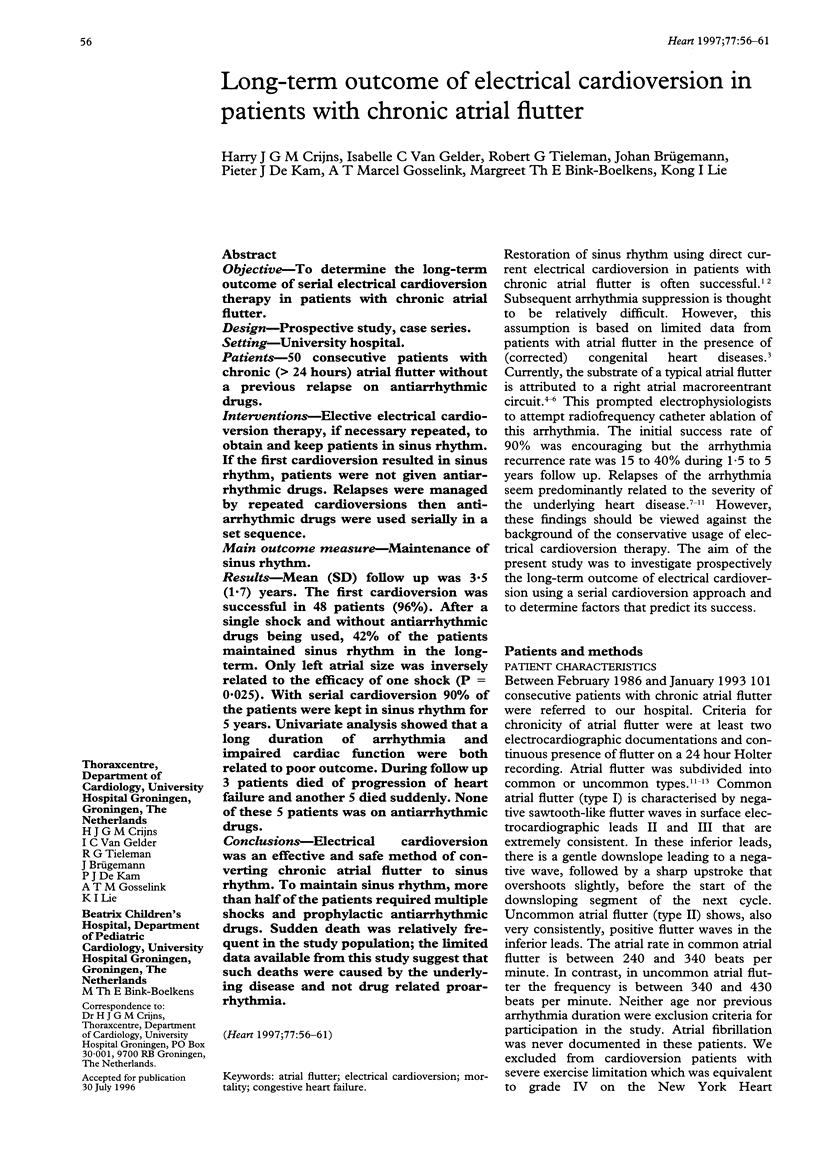
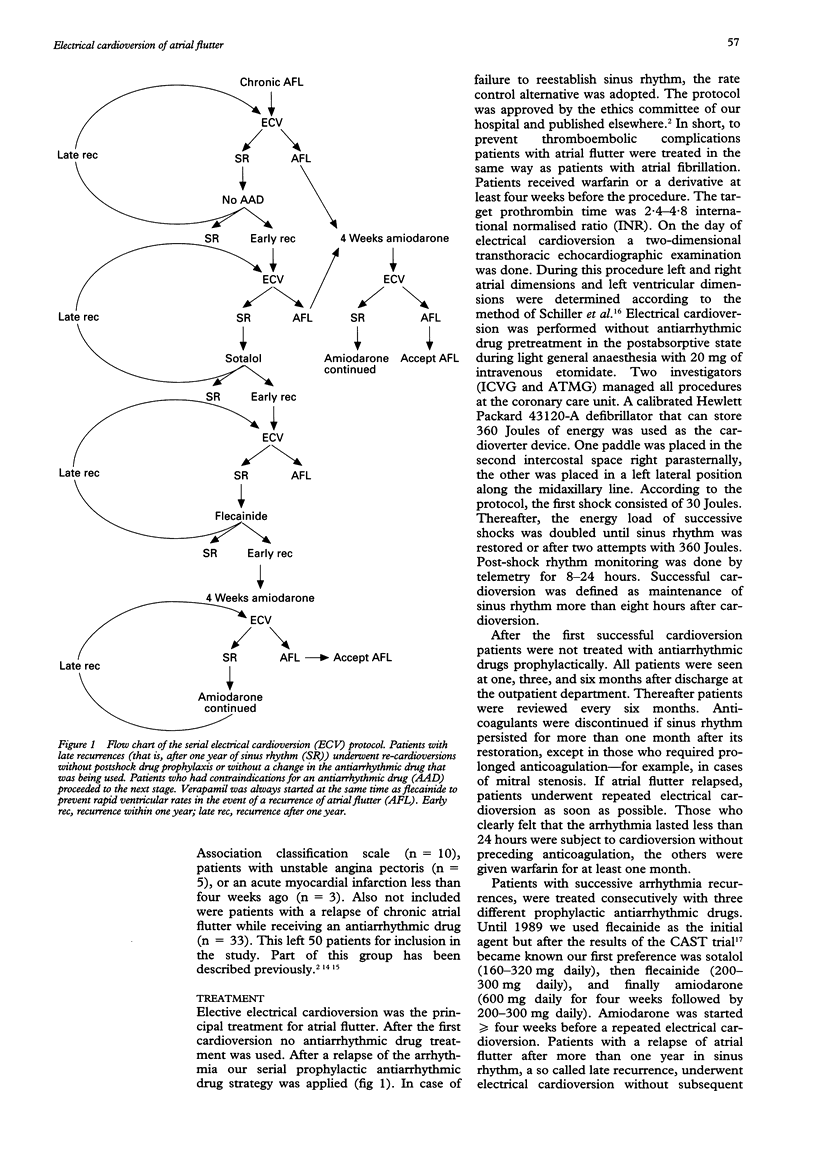
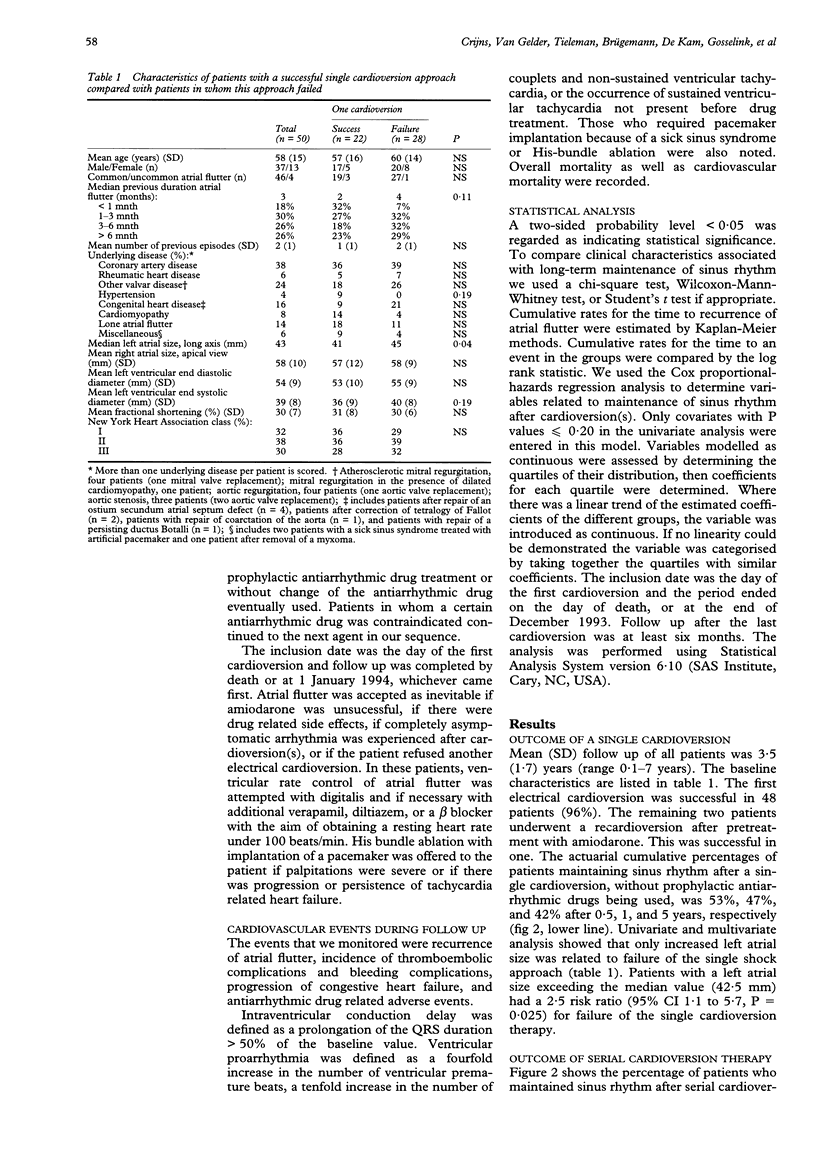
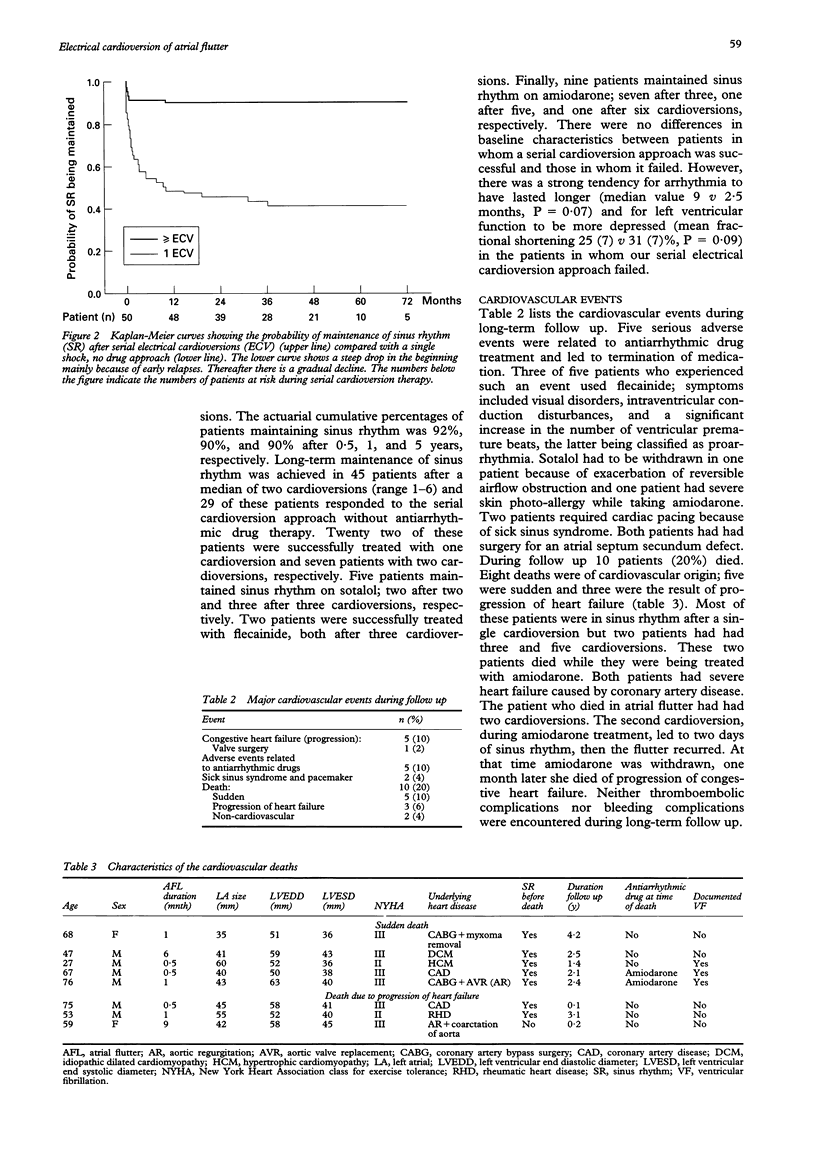
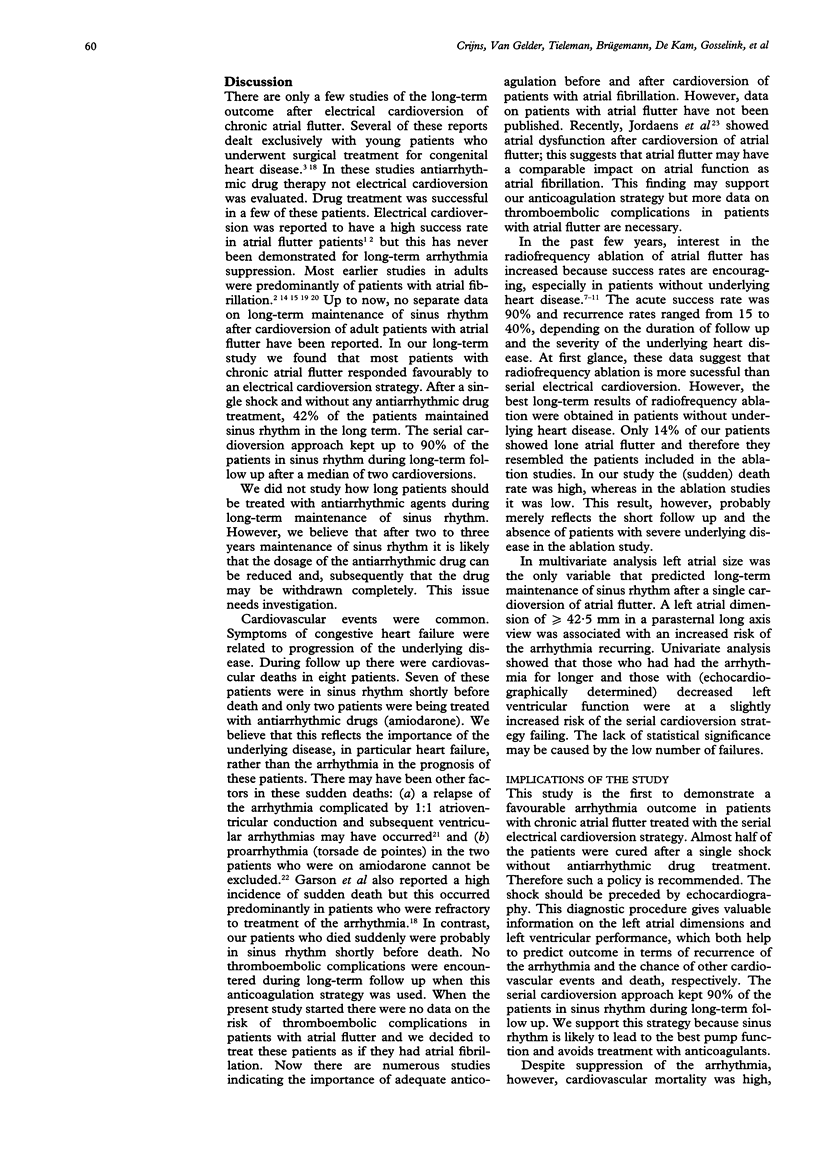
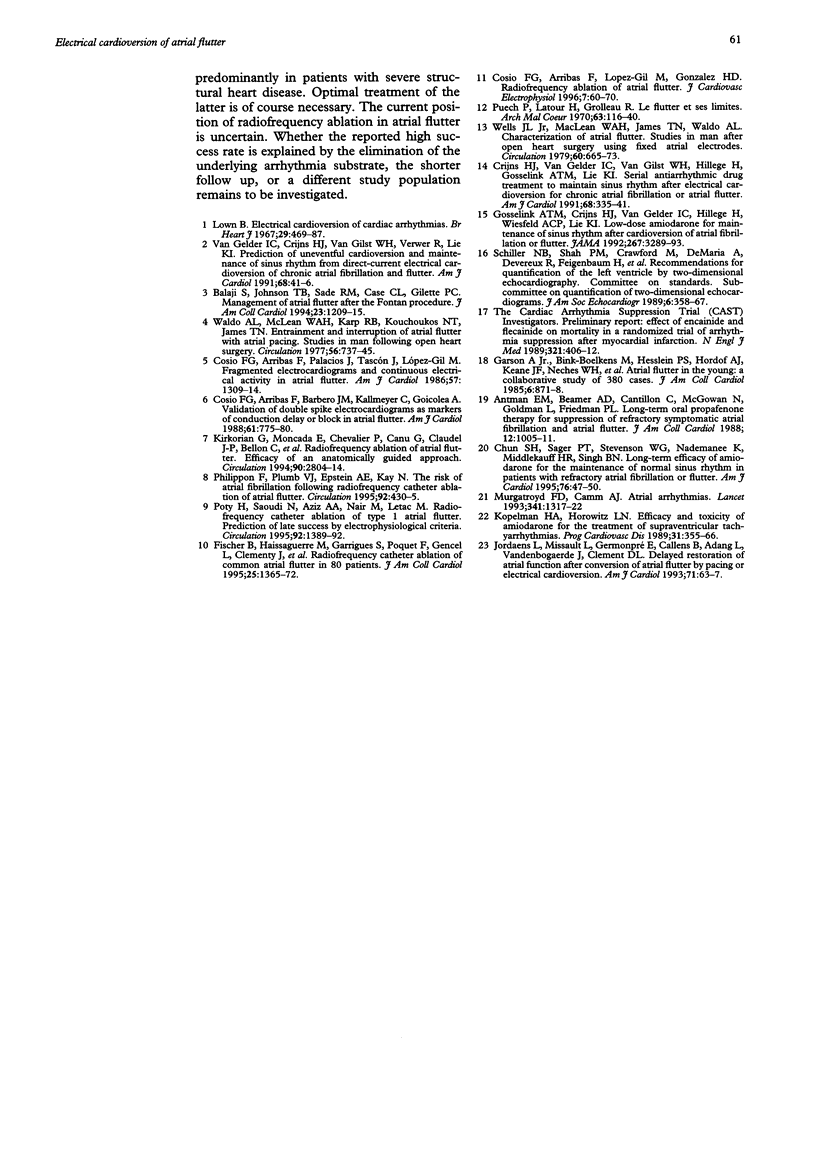
Selected References
These references are in PubMed. This may not be the complete list of references from this article.
- Antman E. M., Beamer A. D., Cantillon C., McGowan N., Goldman L., Friedman P. L. Long-term oral propafenone therapy for suppression of refractory symptomatic atrial fibrillation and atrial flutter. J Am Coll Cardiol. 1988 Oct;12(4):1005–1011. doi: 10.1016/0735-1097(88)90468-8. [DOI] [PubMed] [Google Scholar]
- Balaji S., Johnson T. B., Sade R. M., Case C. L., Gillette P. C. Management of atrial flutter after the Fontan procedure. J Am Coll Cardiol. 1994 Apr;23(5):1209–1215. doi: 10.1016/0735-1097(94)90613-0. [DOI] [PubMed] [Google Scholar]
- Chun S. H., Sager P. T., Stevenson W. G., Nademanee K., Middlekauff H. R., Singh B. N. Long-term efficacy of amiodarone for the maintenance of normal sinus rhythm in patients with refractory atrial fibrillation or flutter. Am J Cardiol. 1995 Jul 1;76(1):47–50. doi: 10.1016/s0002-9149(99)80799-1. [DOI] [PubMed] [Google Scholar]
- Cosio F. G., Arribas F., Barbero J. M., Kallmeyer C., Goicolea A. Validation of double-spike electrograms as markers of conduction delay or block in atrial flutter. Am J Cardiol. 1988 Apr 1;61(10):775–780. doi: 10.1016/0002-9149(88)91065-x. [DOI] [PubMed] [Google Scholar]
- Cosio F. G., Arribas F., Lopez-Gil M., Gonzalez H. D. Radiofrequency ablation of atrial flutter. J Cardiovasc Electrophysiol. 1996 Jan;7(1):60–70. doi: 10.1111/j.1540-8167.1996.tb00461.x. [DOI] [PubMed] [Google Scholar]
- Cosio F. G., Arribas F., Palacios J., Tascon J., Lopez-Gil M. Fragmented electrograms and continuous electrical activity in atrial flutter. Am J Cardiol. 1986 Jun 1;57(15):1309–1314. doi: 10.1016/0002-9149(86)90210-9. [DOI] [PubMed] [Google Scholar]
- Crijns H. J., Van Gelder I. C., Van Gilst W. H., Hillege H., Gosselink A. M., Lie K. I. Serial antiarrhythmic drug treatment to maintain sinus rhythm after electrical cardioversion for chronic atrial fibrillation or atrial flutter. Am J Cardiol. 1991 Aug 1;68(4):335–341. doi: 10.1016/0002-9149(91)90828-9. [DOI] [PubMed] [Google Scholar]
- Fischer B., Haissaguerre M., Garrigues S., Poquet F., Gencel L., Clementy J., Marcus F. I. Radiofrequency catheter ablation of common atrial flutter in 80 patients. J Am Coll Cardiol. 1995 May;25(6):1365–1372. doi: 10.1016/0735-1097(95)00029-4. [DOI] [PubMed] [Google Scholar]
- Garson A., Jr, Bink-Boelkens M., Hesslein P. S., Hordof A. J., Keane J. F., Neches W. H., Porter C. J. Atrial flutter in the young: a collaborative study of 380 cases. J Am Coll Cardiol. 1985 Oct;6(4):871–878. doi: 10.1016/s0735-1097(85)80497-6. [DOI] [PubMed] [Google Scholar]
- Gosselink A. T., Crijns H. J., Van Gelder I. C., Hillige H., Wiesfeld A. C., Lie K. I. Low-dose amiodarone for maintenance of sinus rhythm after cardioversion of atrial fibrillation or flutter. JAMA. 1992 Jun 24;267(24):3289–3293. [PubMed] [Google Scholar]
- Jordaens L., Missault L., Germonpré E., Callens B., Adang L., Vandenbogaerde J., Clement D. L. Delayed restoration of atrial function after conversion of atrial flutter by pacing or electrical cardioversion. Am J Cardiol. 1993 Jan 1;71(1):63–67. doi: 10.1016/0002-9149(93)90711-k. [DOI] [PubMed] [Google Scholar]
- Kirkorian G., Moncada E., Chevalier P., Canu G., Claudel J. P., Bellon C., Lyon L., Touboul P. Radiofrequency ablation of atrial flutter. Efficacy of an anatomically guided approach. Circulation. 1994 Dec;90(6):2804–2814. doi: 10.1161/01.cir.90.6.2804. [DOI] [PubMed] [Google Scholar]
- Kopelman H. A., Horowitz L. N. Efficacy and toxicity of amiodarone for the treatment of supraventricular tachyarrhythmias. Prog Cardiovasc Dis. 1989 Mar-Apr;31(5):355–366. doi: 10.1016/0033-0620(89)90030-3. [DOI] [PubMed] [Google Scholar]
- Lown B. Electrical reversion of cardiac arrhythmias. Br Heart J. 1967 Jul;29(4):469–489. doi: 10.1136/hrt.29.4.469. [DOI] [PMC free article] [PubMed] [Google Scholar]
- Murgatroyd F. D., Camm A. J. Atrial arrhythmias. Lancet. 1993 May 22;341(8856):1317–1322. doi: 10.1016/0140-6736(93)90824-z. [DOI] [PubMed] [Google Scholar]
- Philippon F., Plumb V. J., Epstein A. E., Kay G. N. The risk of atrial fibrillation following radiofrequency catheter ablation of atrial flutter. Circulation. 1995 Aug 1;92(3):430–435. doi: 10.1161/01.cir.92.3.430. [DOI] [PubMed] [Google Scholar]
- Poty H., Saoudi N., Abdel Aziz A., Nair M., Letac B. Radiofrequency catheter ablation of type 1 atrial flutter. Prediction of late success by electrophysiological criteria. Circulation. 1995 Sep 15;92(6):1389–1392. doi: 10.1161/01.cir.92.6.1389. [DOI] [PubMed] [Google Scholar]
- Puech P., Latour H., Grolleau R. Le flutter et ses limites. Arch Mal Coeur Vaiss. 1970 Jan;63(1):116–144. [PubMed] [Google Scholar]
- Schiller N. B., Shah P. M., Crawford M., DeMaria A., Devereux R., Feigenbaum H., Gutgesell H., Reichek N., Sahn D., Schnittger I. Recommendations for quantitation of the left ventricle by two-dimensional echocardiography. American Society of Echocardiography Committee on Standards, Subcommittee on Quantitation of Two-Dimensional Echocardiograms. J Am Soc Echocardiogr. 1989 Sep-Oct;2(5):358–367. doi: 10.1016/s0894-7317(89)80014-8. [DOI] [PubMed] [Google Scholar]
- Van Gelder I. C., Crijns H. J., Van Gilst W. H., Verwer R., Lie K. I. Prediction of uneventful cardioversion and maintenance of sinus rhythm from direct-current electrical cardioversion of chronic atrial fibrillation and flutter. Am J Cardiol. 1991 Jul 1;68(1):41–46. doi: 10.1016/0002-9149(91)90707-r. [DOI] [PubMed] [Google Scholar]
- Waldo A. L., MacLean W. A., Karp R. B., Kouchoukos N. T., James T. N. Entrainment and interruption of atrial flutter with atrial pacing: studies in man following open heart surgery. Circulation. 1977 Nov;56(5):737–745. doi: 10.1161/01.cir.56.5.737. [DOI] [PubMed] [Google Scholar]
- Wells J. L., Jr, MacLean W. A., James T. N., Waldo A. L. Characterization of atrial flutter. Studies in man after open heart surgery using fixed atrial electrodes. Circulation. 1979 Sep;60(3):665–673. doi: 10.1161/01.cir.60.3.665. [DOI] [PubMed] [Google Scholar]


